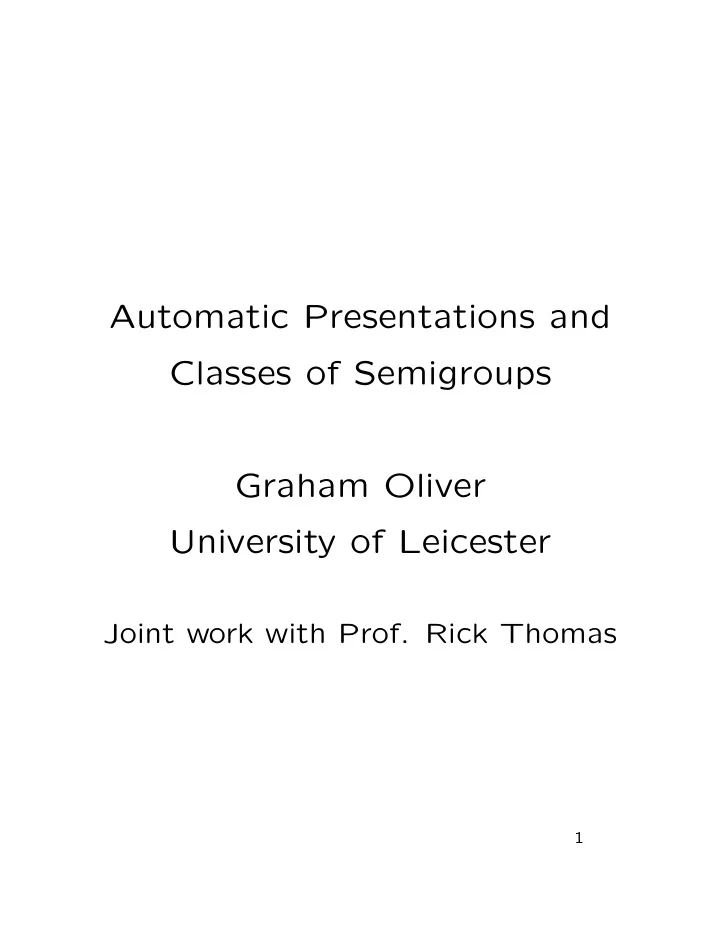

Automatic Presentations and Classes of Semigroups Graham Oliver University of Leicester Joint work with Prof. Rick Thomas 1
Automatic Presentations • Finite presentations of infinite structures • Generic approach to deciding FO theory • Restriction of recursive structures • Inspired by theory of automatic groups and automatic semigroups 2
Automatic Presentations x = x 1 x 2 . . . x r y = y 1 y 2 . . . y s | x | ≤ | y | Convolution of x and y , conv( x, y ), is: � � � � � � � � � � � � x 1 x 2 x r . . . . . . y 1 y 2 y r y r +1 y s An Automatic Presentation for a structure ( S, R 1 , . . . , R n ) consists of: • Regular language L ⊆ Σ ∗ • Surjective map: θ : L → S • L = = { conv( x 1 , x 2 ) : θ ( x 1 ) = θ ( x 2 ) } is regular • L R i = { conv( x 1 , . . . , x k ) : R i ( θ ( x 1 ) , . . . , θ ( x k ) } is regular 3
Automatic Presentations For a structure S with an automatic presenta- tion: • The FO -theory of S is decidable • If T is FO -interpretable in S then T has an automatic presentation • S is FO -interpretable in ( N , + , | 2 ) • S is FO -interpretable in ( { 0 , 1 } ⋆ , � , P 0 , P 1 , el ) 4
Semigroups ( S, ◦ ), where ◦ is an associative binary function. 1. Examples: (a) Σ = { a, b } , (Σ ⋆ ◦ ) where e.g. aba ◦ bbb = ababbb (b) ( N , ◦ ) , ( Z , ◦ ) , ( Q , ◦ ) , ( R , ◦ ) , ( C , ◦ ) where ◦ ∈ { + , ×} (c) (Partial) Automorphisms 5
Groups • 1 ◦ s = s ◦ 1 = s • ∃ s − 1 , s ◦ s − 1 = 1 = s − 1 ◦ s A group is virtually abelian if it contains an abelian subgroup of finite index. Theorem (G.O, R.Thomas STACS05): A f.g. group G has an automatic pre- sentation if and only if G is virtually abelian Corollary: The class of f.g. groups with automatic presentations is properly contained in the class of automatic groups . 6
Commutative Semigroups • x ◦ y = y ◦ x Theorem (Taitslin): All f.g. commutative semigroups are FO -interpretable in ( N , +). Corollary: All f.g. commutative semigroups have automatic presentations . Note: There exists a f.g. commutative semigroup that is not automatic . (Hoffmann, Thomas) 7
Cancellative Semigroups • a ◦ x = a ◦ y ⇒ x = y • x ◦ b = y ◦ b ⇒ x = y Proposition (G.O, R.Thomas): If a f.g. semigroup S has an automatic presentation, then S has polynomial growth Let G S = { s − 1 ◦ t : s, t ∈ S } . If G S is a group, it is called the group of (left) quotients of S . Proposition (Grigorchuk): If a f.g. cancellative semigroup S has polynomial growth , then S has a group of (left) quotients G S 8
Cancellative Semigroups S - semigroup, G S - group of (left) quotients Proposition: G S is FO -interpretable in S FO -interpretation: θ ( x, y ) := ∀ z, z = z f : S 2 → G f ( s, t ) = s − 1 ◦ t θ = ( x 1 , y 1 ; x 2 , y 2 ) := ∃ p, q ( x 1 ◦ p = y 1 ◦ q ∧ x 2 ◦ p = y 2 ◦ q ) θ ◦ ( x 1 , y 1 ; x 2 , y 2 ; x 3 , y 3 ) := ∃ p, q ( x 3 = p ◦ x 1 = q ◦ y 2 ∧ y 3 ∧ q ◦ x 2 = p ◦ y 1 ) 9
Cancellative Semigroups Theorem: Let S be a f.g. cancellative semigroup with an automatic presentation ; then, S embeds in a virtually abelian group. Proof: The group of (left) quotients of S , G S , has an automatic presentation; so, G S is virtually abelian. Conjecture: A f.g. cancellative semigroup S has an automatic presentation if and only if S embeds in a virtually abelian group. 10
Conclusion Theorem: A f.g. group G has an automatic pre- sentation if and only if G is virtually abelian Theorem: All f.g. commutative semigroups have automatic presentations . Theorem: Let S be a f.g. cancellative semigroup with an automatic presentation ; then, S embeds in a virtually abelian group. 11
Recommend
More recommend